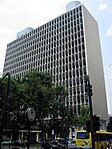Cinelândia Station
Brazil transport stubsBrazilian building and structure stubsMetrô Rio stationsRailway stations opened in 1979South American railway station stubs ... and 1 more
South American rapid transit stubs

Cinelândia Station (Portuguese: Estação Cinelândia) is a station on the Rio de Janeiro Metro that services the Praça Marechal Floriano (commonly known as Cinelândia) public square in the Centro neighborhood of Rio de Janeiro, Brazil. The station is located on the site of the former Monroe Palace, which served as home to Brazil's Senate from the 1930s to 1960s.
Excerpt from the Wikipedia article Cinelândia Station (License: CC BY-SA 3.0, Authors, Images).Cinelândia Station
Rua Francisco Serrador, Rio de Janeiro Centro (Zona Central do Rio de Janeiro)
Geographical coordinates (GPS) Address Nearby Places Show on map
Geographical coordinates (GPS)
| Latitude | Longitude |
|---|---|
| N -22.910889 ° | E -43.175772 ° |
Address
Praça Floriano Peixoto
Rua Francisco Serrador
20031-010 Rio de Janeiro, Centro (Zona Central do Rio de Janeiro)
Rio de Janeiro, Brazil
Open on Google Maps






